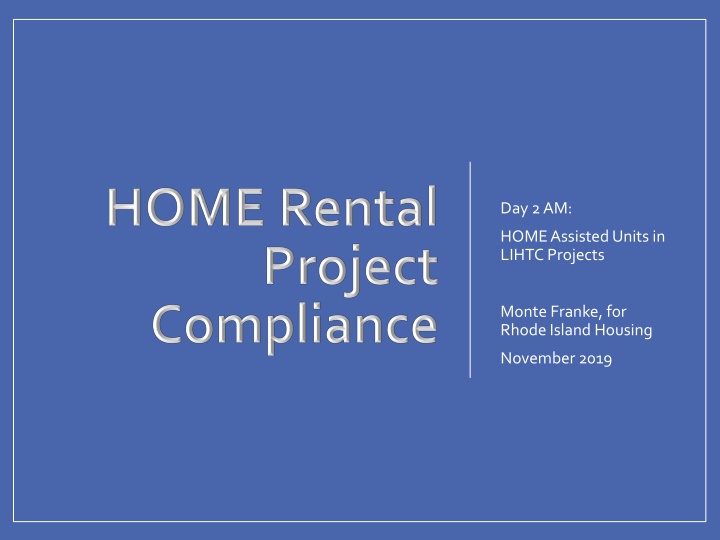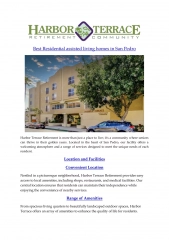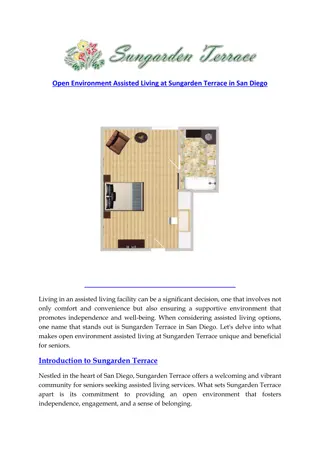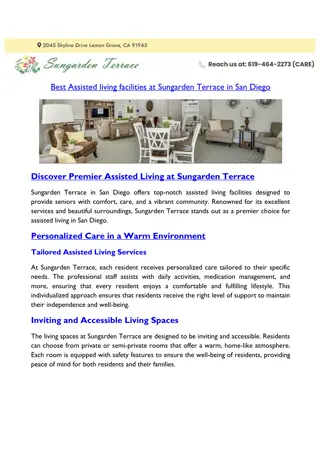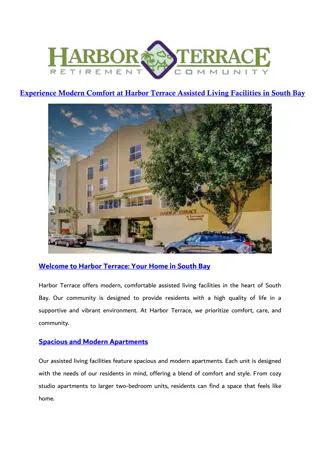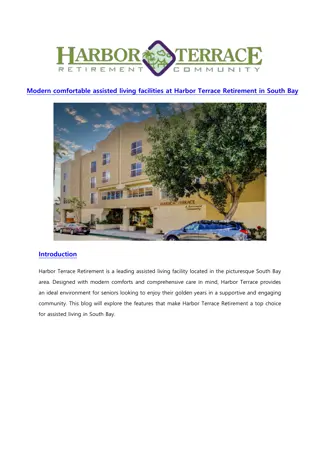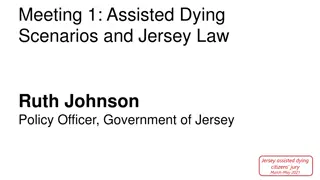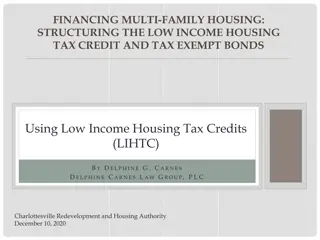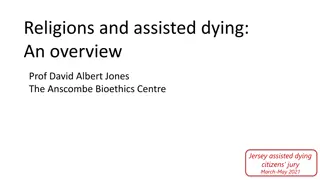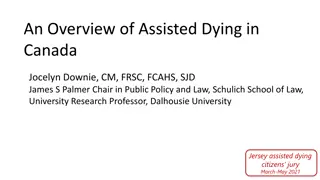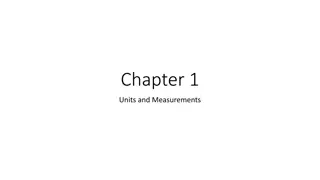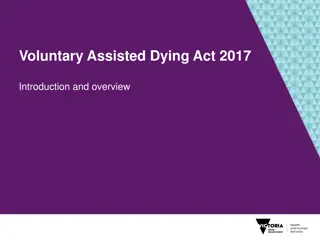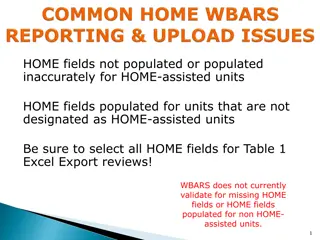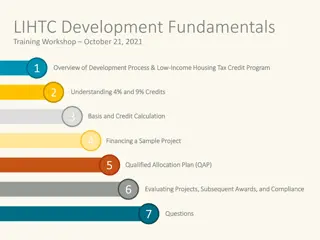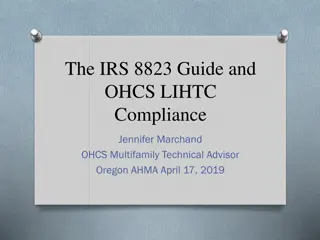Compliance Requirements for HOME Assisted Units in LIHTC Projects
Review the key compliance requirements for HOME assisted units in LIHTC projects, including initial occupancy differences, ongoing compliance standards, rent limits, property standards, and affordability periods. Understand the rules related to income limits, occupancy percentages, rent calculations, and property inspections to ensure successful project compliance.
Download Presentation

Please find below an Image/Link to download the presentation.
The content on the website is provided AS IS for your information and personal use only. It may not be sold, licensed, or shared on other websites without obtaining consent from the author.If you encounter any issues during the download, it is possible that the publisher has removed the file from their server.
You are allowed to download the files provided on this website for personal or commercial use, subject to the condition that they are used lawfully. All files are the property of their respective owners.
The content on the website is provided AS IS for your information and personal use only. It may not be sold, licensed, or shared on other websites without obtaining consent from the author.
E N D
Presentation Transcript
Day 2 AM: HOME Assisted Units in LIHTC Projects Monte Franke, for Rhode Island Housing November 2019
HOME Units in LIHTC Projects HOME Requirements Review Combining HOME & LIHTC Initial Occupancy Differences Ongoing Compliance Differences 2
NAHA 24 CFR Part 92 92.252: rental requirements 92.253: lease requirements & prohibitions 92.251: property standards 92.203: income methods & documentation CPD Notices HUD Guidance PJ Policy https://www.hudexchange.info/programs/ home/home-laws-and-regulations/ https://www.hudexchange.info/resource/ 2395/compliance-in-home-rental- projects-a-guide-for-property-owners/ 4
Cornerstone compliance issues: right Ps right people, prices, properties, period of time Income Limits Prop Standard Rent Limits Affordability Period 5
Occupancy: If 5+ units, at least 20% @ 50% AMI (VLI): Project Rule 90% initial occupants @ 60% AMI: Program Rule All assisted units @ 80% AMI (LI) If less than 100%, fixed v. floating Cost allocation to determine unit mix 18 months from completion to initially occupy assisted units (or repay) HUD requires report after 6 months 6
Rent limits: Published annually by HUD: LI units: lesser of 30% at 65% or FMR VLI: lesser of 30% @ 50% or FMR Total contract rent Includes TBRA payments Project-based assistance exception Adjusted for tenant-paid utilities 7
Property Standards: State/local codes & UPCS (2013 rule) HUD to issue further guidance Accessibility Lead-based paint: annual: visual assessment, paint stabilization HAUs must pass inspection: prior to occupancy during the compliance period 8
Minimum Affordability Period less than $15,000 HOME/unit $15,000 - $40,000 greater than $40,000 or refinance new construction 5 yrs 10 yrs 15 yrs 20 yrs PJ can have longer local restrictions Affordability period starts w/ IDIS completion Construction completion; prop standards; funds disbursed Secured by deed restriction/covenant Regulatory Agreement, note & mortgage 9
Combining HOME with Other Public Subsidies 10
Many HOME projects have other public subsidies If combined with other funds, general guidance is to comply with both HOME & the other program(s) requirements But only for the HOME-assisted units You will be monitored separately for each program May be coordinated if same agency or interagency agreement 11
Usually following most restrictive rule will cover both programs, e.g.: HH income use lowest limit Maximum contract rent (rent limit adjusted for utility allowance) use lowest contract rent calculated But not always: Property standards combine; inspected for both Over-income rent conflicting requirements 12
HOME can be provided to units with PBA HOME rules apply to HOME assisted units Key differences: Income limits published at different times; check HOME limits Maximum rent: If PBA & HOME VLI (50% AMI) unit, PBA sets the rent If not designated as VLI unit, HOME rent limit applies to total contract rent plus utility allowance Ongoing inspection standards are different - state/local codes & UPCS deficiencies v. HQS 13
This training addresses the HOME differences it does not cover LIHTC or compliance items that are the same for the two programs. See the LIHTC Compliance Manual: https://www.rihousing.com/wp- content/uploads/RIHousing_LIHTC_C ompliance_Manual_March_2019.pdf & the Multiple Programs Guide supplement (at end of manual) 15
LIHTC - likely to be all units (applicable fraction) But HOME assisted units are determined by cost allocation/designation Units that are both LIHTC & HOME-assisted must meet both rules Units without HOME only need to meet LIHTC rules T T T T T T T T LOW H H HIGH LOW H LOW H LOW H T H HIGH H HIGH H LOW H T H HIGH H HIGH 16
Initial Occupancy Occupancy mix Affirmative marketing Income limits , definitions, verification Student households Rent calculations (& utility allowances) Leases Property standards & inspections Ongoing Compliance Period of affordability v compliance period Maintaining the Mix Re-examination Over income rules Rent changes Monitoring 17
LIHTC typically all unit Traditionally 50% AMI and 60% AMI (Income Averaging option) HOME HAU # & size mix determined in cost allocation All HAUs: 80% AMI (but 60% initial occupancy*) If 5+ HAUs, at least 20% of HAUs 50% AMI (HOME units must be initially rented within 18 mos or repayment) If HAU/LIHTC unit, both program requirements must be met 18
Both programs subject to Fair Housing Act Discrimination in leasing, terms and conditions of rental units, & advertising prohibited Recent disparate impact decisions/policy VAWA applies to both Affirmative marketing required by HOME for projects with 5 or more HOME-assisted units PJ specifies outreach activities/procedures and sharing with project owner. Plan must include special outreach to those least likely to apply HOME: PJ approval of tenant selection procedures Rejected applicants must receive written explanation
LIHTC: HUD mulit-family income limits HERA exceptions/hold harmless HOME: income limits are published separately at www.hudexchange.info Lag time between LIHTC & HOME limits Lowest limit applies to LIHTC/HOME unit 20
Both can use Section 8 (Part 5) definition of annual (gross) income When programs combined in same unit, use lowest income limit Asset income must be included but LIHTC allows for tenant certification of assets when $5000, imputed income over $5,000; HOME requires all asset income to be verified & imputed income HOME rule requires 2 mos. source documentation LIHTC verification good for 120 days; HOME 6 mos. Verification forms? RIH specifies Records: LIHTC 6 years; HOME 5 years 21
LIHTC: limits any fulltime (5 mos) student HHs Unless T ANF, JTPA/WIA, foster care, married, single parent HOME follows Section 8 (Part 5) rule: student FT/PT < 24 ineligible unless Independently eligible / member of eligible HH Veteran Married (including same-sex) Has dependent child Similar but different requirements Separately apply the eligibility criteria Also different treatment of fin assistance > tuition/fees Treatment on recertification different 22
Owner, officers, board, employees, consultant, or immediate family members) can t occupy assisted unit without the prior written exception by PJ Does not apply to an employee/agent who occupies a rental housing unit as the project manager or maintenance worker PJ employees/officials also subject to conflict of interest (must be cleared by HUD) 23
Each program publishes (different) rent limits LIHTC: 30% at 50% or 60% HOME: Low HOME (30@50% or FMR); High HOME (30% @ 65% or FMR) Both subtract utility allowance HOME limit HOME UA = max HOME contract rent LIHTC limit LIHTC UA = max LIHTC contract rent Combined limit: lower of two 24
Both programs require utilities be deducted from max rent limit to determine max contract rent PJ can use actual utility costs, HUD utility schedule model, or certain estimates See HOMEfires vol 13 no 2 May 2016 LIHTC may use different schedule than HOME PJ may adopt LIHTC utility schedule
Rent limit & TBRA (HCV/Sn 8) different LIHTC: rent limit restricts tenant contribution HOME: total contract rent may not exceed rent limit Annual limits: affordability/compliance period HOME: rent limits effective 30 days after publication LIHTC: State allocating agencies issue new rent limits Issues: Rent limits issued & effective at different times Programs have different floor & hold harmless provisions (HOME rent limits can drop) HOME: floor is initial rent limits at commitment LIHTC: establish floor rents at allocation or carryover 26
HOME more stringent requirements than LIHTC Leases are required One year term at minimum (unless mutually agreed); LIHTC minimum is 6 months Renewal: at PJ discretion PJ must review and approve lease forms RIH Lease Addenda: program & VAWA Must include rent AND procedures for adjustments to rents PJ/owner cannot require mandatory service program participation
Standards for HOME & LIHTC differ HOME: state/local codes, min UPCS deficiencies (not yet issued) LIHTC: 2019 rule changes: Min Unit Sample Size Reference Chart, REAC protocols, notice, different file sample Inspections: HOME: PJ must inspect for HOME compliance; 1st year & every 3rd year LIHTC: State allocating agency inspects for LIHTC
Minimum affordability/compliance period varies Start of affordability period: completion LIHTC: Completion is placed in service date (building by building after construction complete & first unit is occupied by eligible tenant HOME: project completion in IDIS Completion dates likely to vary; HOME affordability period & LIHTC compliance period not likely to be exactly same HOME obligations remain on sale (e.g., min 20 year new construction continues in event of 15 year sale)
LIHTC Must examine income annually Possible exception for 100% LIHTC projects 3rd party source documents annually HOME permits 3rd party documentation every 6th year of affordability period PJs may choose to apply only to small projects
Must maintain total number of HOME & LIHTC & non-HOME units Unit #/mix designated in written agreements E.g.: If agreement dictates 10 HOME units, owner is not required to have 11 units with HOME restrictions HOME: Must maintain proportion of Low & High HOME rent units Min Low HOME: 20% of HOME-assisted units (5+) Actual percentage established in written agreement HAUs can be fixed or floating per agreement
Different definitions of over income LIHTC: above 140% of income limit HOME: above 80% AMI OI tenants not required to move But rent may change: LIHTC: rent remains capped at LIHTC level until next available unit is swapped (if less than 100%) HOME: tenant pays 30% of Adjusted Income If floating, up to unrestricted rent, change to unrestricted when replaced by next available unit rule In units with both HOME & LIHTC Rent is 30% of Adjusted Income up to LIHTC rent limit 33
Adjust rent on renewal subject to LIHTC May use High HOME rent limit after unit swap Franke Consulting Group 34
PJ must affirmatively approve/reject project rents each year per 92.252(f)(2) PJ schedule need not align w/ calendar year Likely impacts on rent levels & trending assumptions Rents may go up or down HOME units not required to go lower than initial rents in HOME agreement 35
Both programs: May terminate tenancy or refuse to renew lease only for good cause: Serious or repeated violation of the lease terms Violation of applicable Federal, state or local law Other good cause (increase in income is not good cause) Both subject to VAWA in cases of domestic violence Can terminate in transitional housing for failure to comply with service plan or end of transition HOME: 30 day notice required 36
HOME inspections: PJ must inspect for HOME compliance; 1st year & every 3rd year Statistically valid sample; files do not have to be same as inspections State/local codes & UPCS deficiencies list (to be published) LIHTC inspections: State allocating agency inspects for LIHTC 2019 rule change deferred until 2020 RIH continues to follow Revenue Procedure 2016-15 for now
HOME: Annual Rent & Occupancy report required Tenant info uploaded during year, but annual certification required Owner must certify to property standards HOME: Financial Oversight required if 10+ HOME units Risk based oversight policies required Onsite inspections/file reviews: 1st year + not less than every 3rd year Re-inspection varies based on violation severity PJ may coordinate with LIHTC review, but must meet specific HOME requirements 38
Go to HUD Exchange: https://www.hudexchange.info/programs/home/ Sign up for mailing list: https://www.hudexchange.info/mailinglist/ Download Compliance in HOME Rental Projects: https://www.hudexchange.info/resource/2395/co mpliance-in-home-rental-projects-a-guide-for- property-owners/ Thanks for attending! Follow up questions 40
